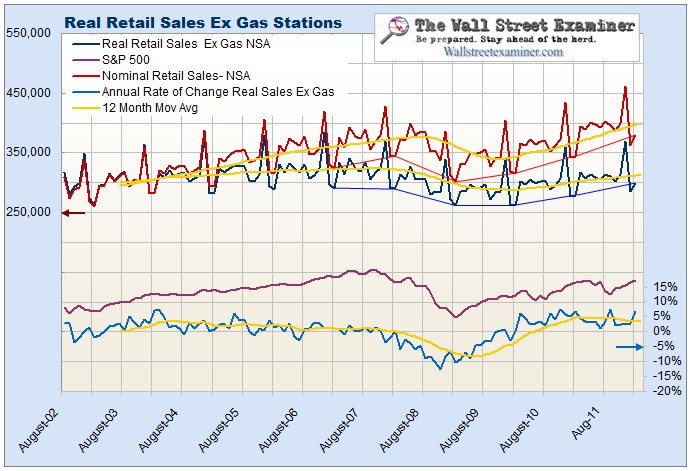Strongest Retail Sales of the Century, But Pundits Fail to Blame Weather

Courtesy of Lee Adler of the Wall Street Examiner
As was typical of this morning’s reporting on the Commerce Department’s advance retail sales release for February, Marketwatch (Dow Jones) reported that the 1.1% gain (seasonally massaged) was the fastest in 5 months. It missed their consensus expectations, but only by a tenth of a percent. Bloomberg also touted the gain as the biggest in 5 months, with the gain being perfectly in line with their consensus survey expectation. Reuters had virtually the exact same headline and story lead-in as its two major competitors. They’re losing so much money that they can’t afford original reporting. Or to give them a little more credit than that, maybe they all just use the same computer Al Gore Rhythm to write the stories.
I don’t know how you can compare month to month seasonally falsified numbers to one another with a straight face, but the actual data wasn’t bad, even after adjusting for inflation and backing out gasoline sales, which skew the numbers. Given the way the mainstream media reports the data, it’s an accident when the actual data supports the seasonally fictionalized data, but in this case, that’s what happened. In fact, the media reports actually understate just how strong February was. To put it bluntly, the actual numbers were blockbusters.
Starting with the raw survey, actual data, retail sales for February came in at just under $380 billion. That was up a whopping 10.34% over February 2011. Even after adjusting for CPI inflation, it was still a 7.2% gain. That compares with a 7.4% year over year gain in February 2011. On that basis the economy seems to be perking right along.
February sales were up 4.6% versus January. That’s the strongest February gain of the 21st century. February is usually a little weaker than January because the weather is still lousy and it has 10% fewer days than January. The average month to month change over the previous 10 years was a drop of 1%. Even excluding recession years, the average change was -0.4%. That makes this February look all the more impressive.
When economic data comes up short of expectations, the pundits like to blame the weather. When the numbers are strong, as with this month’s retail sales, do you hear anyone giving credit to the weather? Everyone knows that the weather was springlike in February in most of the US. Temperatures were well above normal. Not to be a spoil sport, but that probably had something to do with the strong sales, and it could represent demand pulled forward from the spring shopping season. Good for February, not so good for March and April.
As I explained the last time I looked at this data, I like to subtract gasoline sales. Gas prices are volatile and gas sales account for nearly 10% of total retail sales. Big changes in gas prices can abnormally skew total sales in a counter trend way, because gas prices act more like a tax. While adding to total sales when gas prices have risen as they did in February, that actually subtracts from discretionary spending and other retail sales. When gas prices have dropped, that reduces total sales but actually adds to discretionary spending and other retail sales. When gas price changes are small, the impact on overall sales trends isn’t material, but large changes in gas price levels over time can create a false impression regarding total retail sales.
The chart illustrates just how far out of whack nominal total retail sales have gotten versus real retail sales ex gas. The red line is nomimal retail sales before any adjustments. They appear to be booming. The dark blue line represents real retail sales with gasoline sales removed. That trend is far less robust. In fact, February was the first time that this index exceeded the record high for the same months, set in 2007. It has taken 5 years for unit sales excluding gasoline to recover to where they were then, and there are about 5% more people in the US today. It’s an indication that more people are falling behind, and fewer people are doing better in the US. Trend growth has been anything but robust, but the past 12 months have shown some acceleration.
After backing out gas station sales, the 12 month change was 6.7%, which is not too shabby. The month to month gain was a strong 4.9%. Again, that’s the best gain since 2000. Any way you slice it, this is a strong report.
What does any of this have to do with stock prices? There has been some correlation between the rate of change in retail sales ex gas and stock prices. It appears that changes in the momentum of real retail sales ex gasoline lead significant moves in stocks. The growth rate trended down from February to July of 2011, foreshadowing the summer break in stocks. But from 2004 to 2007, stocks kept rising even in the face of steadily weakening growth in this indicator. So the period of negative divergence can be very long before stock prices break. The current annual growth rate of 6.7% is consistent with a strongly bullish stock market.
Both negative and positive divergences between the growth rate of real retail sales ex-gas and stock prices have given useful signals at times. At the moment, there’s no negative divergence. As long as this growth rate indicator stays on the positive side, a bear market or even a big intermediate correction, doesn’t look likely. However, if the reason for February’s surge was the weather, then retail sales growth will slow over the next couple of months. If stocks continue to advance while retail sales growth weakens, that would set up the kind of negative divergence that usually leads a big correction. The timing could be remarkably similar to last year and 2010, when the stock market topped out in April or May, and broke in May or June.
Get regular updates the machinations of the Fed, Treasury, Primary Dealers and foreign central banks in the US market, in the Fed Report in the Professional Edition, Money Liquidity, and Real Estate Package. Click this link to try WSE’s Professional Edition risk free for 30 days!
© Copyright 2012, The Wall Street Examiner Company Inc. All rights reserved.
Attention third party re-publishers: This article may be reposted only in its entirety with a prominent link to http://wallstreetexaminer.com or other page on this website. Any changes to the article, or other use without the expressed written consent of Lee Adler is unauthorized.




